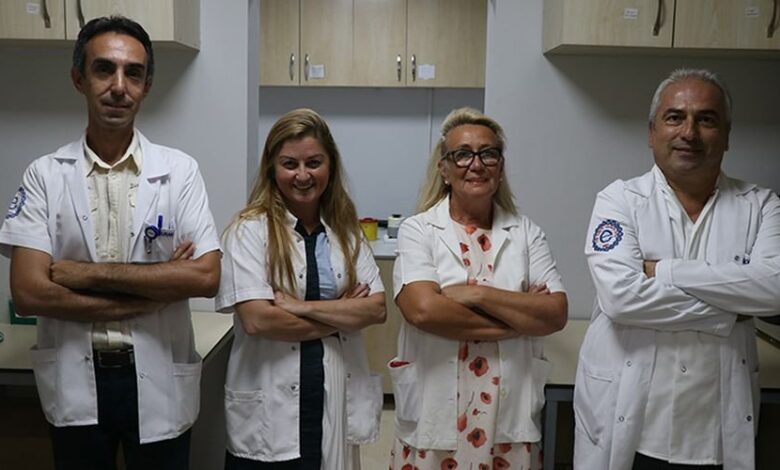
Scientists working at Ege University (EU) Faculty of Medicine determined that the 24-year-old girl, whose disease could not be diagnosed for 19 years, was caused by a new genetic disease.
B.Y, who was born as a result of consanguineous marriage in Torbali district in Izmir, was taken to the hospital by his family with the complaints of a 5-year-old child with stiffness in the joints of his fingers and toes, inward bending of the fingers, spasms in the arms and legs, skin hardening and severe pain.
At the end of the test and examination, it was thought that it might be a rheumatic disease and treatment was started. The patient did not respond positively to the treatment, and after a while, loosening problems in the meniscus and heart valve arose. When B.Y was 11 years old, he was brought to Ege University Children’s Hospital by his relatives.
EU Pediatric Diseases Department Head Prof. Dr. Ozgur Plural and lecturer Prof. Dr. Ferda Ozkinay, faculty members of the Department of Medical Genetics Assoc. Dr. Ayca Aykut and Assoc. Dr. Burak Durmaz, thinking that the health problem in B.Y. might be a genetic disease, did tests.

As a result of the tests, scientists, who thought that the patient’s disease could be a new genetic disease that has not yet been defined with his complaints, findings and history, interviewed with their colleagues about the health problem experienced by their patients at scientific congresses held in Turkey and abroad.
In this context, in cooperation with scientists working at Baylor College of Medicine in the United States, a mutation in the “ADAMTS15” gene was detected in the DNA sequencing analysis performed with a new technology, whole exome sequencing, in 2013.
Prof. Dr. Plulu and his team re-evaluated the genetic data at Ege University and determined that the problematic gene in their patients would be “ADAMTS15” and continued their studies in this direction.
Turkish scientists continued their studies without interruption after the health problems experienced by their patients. After the patient’s findings were uploaded to an international database in 2018, 4 more similar cases from 3 families, first in Germany and then in England, were reported to the same database, and Turkish scientists were offered an international study.
Turkish and foreign scientists obtained data supporting the findings of human disease in cell cultures and mouse embryos.
prof. Dr. The genetic discovery of Prof. Dr. Plul and his team was accepted by the journal “Genetics in Medicine” as a result of international collaboration and research.

“These complaints are findings concerning the connective tissue in particular”
Hospital Chief Physician and Faculty Member of the Department of Pediatric Genetics, Prof. Dr. Ozgur Coklu told Anadolu Agency (AA) that his patients are now 24 years old and that his health problems continue.
Stating that they revealed for the first time as a team that the disease may be related to this gene and announced to the world, Coklu said:
“Proteins are produced in our body. Produced proteins have vital functions in organs and tissues. Collagen is also a type of protein. In a gene known as connective tissue and located in this tissue, a faulty DNA sequence is required instead of the correct DNA sequence, which is required for a protein related to cell structure to be produced without error. Because of the knee, protein is produced incorrectly and insufficiently, and signs of disease occur due to this. Since the most important connective tissue is the skin and joints, health problems such as contractures, hardening and meniscus in the hands, feet and joints first appeared in our patient. findings that concern its tissue.”
Emphasizing that the “ADAMTS15” gene is a protein that ensures that the connective tissue stays strong, Coklu said that when there is a defect in this, the connective tissue does not develop and hardens, just like the curvature of a building’s column.
Stating that the underlying cause of this disease has not yet been determined, and that both they and foreign scientists continue to work, Coklu said:
“If we can explain the mechanism of this in detail, then we will be able to treat it. We are investigating our hypotheses about the cause of the disease. 15 years have passed from 2007 to 2022. During this period, the entire genetic structure of the patient was examined. In 2019, international research began. In 2011, it was stated that this disease is a new disease. “We started to think about it. Scientists research, insist and cooperate. We persistently pursued this disease. We are proud that a new disease was first identified by us.”
EU Rector Prof. Dr. Necdet Budak, on the other hand, stated that their universities continue to break new ground especially in the field of health, and Prof. Dr. He wished the team and his team every success.






